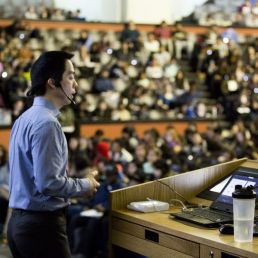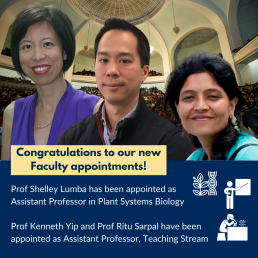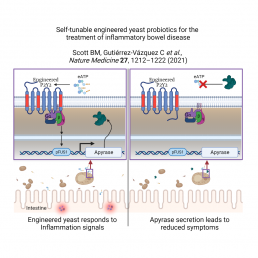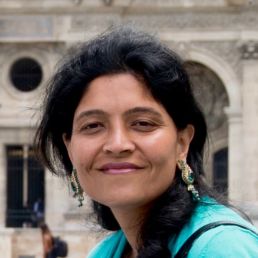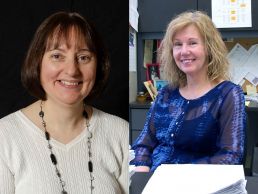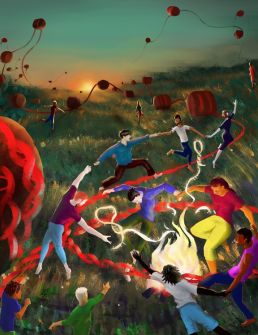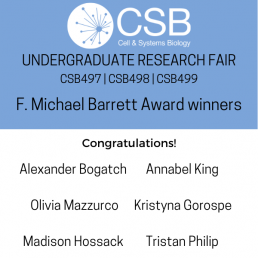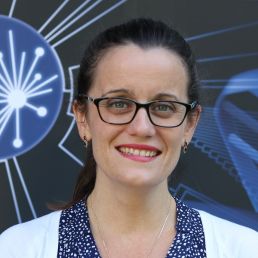Finding Fulfillment in a Fine Lecture with Prof Kenneth Yip
Prof Kenneth Yip learned early in his career that he really enjoys teaching from giving classes as a post-doctoral researcher. “I love to see that students are excited about science and I enjoy hearing questions that show they understand the material and are eager to learn more. My favourite feeling is finishing a lecture that I know has been well understood!” Yip’s dedication has earned him a promotion to Assistant Professor in the Department of Cell & Systems Biology.
Yip is often the first professor for life sciences students in the introductory BIO130 course, who may encounter him again in second year Biotechnology or third year Cellular Dynamics courses. He structures his lessons to be clear and easy to understand with anecdotes about the process of scientific discovery. His teaching techniques use evidence-based strategies to improve student success and have made him a favourite instructor for many students.
Yip’s research at the Princess Margaret Cancer Centre means that his students learn the latest advances in molecular and cell biology. He is proud that his recent research revealed a new mechanism of radiation-induced fibrosis, and allowed development of drugs to regulate the metabolic dysregulation behind this syndrome. In addition to practical bench skills, Yip has expanded his knowledge by studying regulatory compliance, bioethics, and online instruction techniques. A further biological phenomenon that Yip craves is the rumble deep in his body that comes from watching Formula One racing.
Graduate Teaching Assistants who provide a more personal approach to the thousands of students who take introductory biology rely on Yip for guidance on their teaching. He mentors these TAs by encouraging them to think about what they want to achieve through the course, by guiding the more mature senior students to lead their peers, and by helping them with CVs and applications.
Yip works closely with Prof Melody Neumann on testing innovative pedagogical techniques in the classroom. He wants to use the freedom afforded by his new appointment to build on these collaborations and develop some of his own innovations. Congratulations, Professor Yip!
Congratulations to our new Faculty!
Cell & Systems Biology has Professors in three newly appointed posts starting on July 1, 2021!
Professor Shelley Lumba has been appointed as Assistant Professor in Plant Systems Biology at Cell and Systems Biology. Lumba studies molecular mechanisms of dormancy and germination in plants in the Earth Sciences Building. Her lab uses systems biology approaches to generate signalling networks underlying germination in the model plant Arabidopsis thaliana and in parasitic plants, such as Striga hermonthica. She was formerly a contractually limited term appointment, but will now qualify to apply for tenure.
Professor Kenneth Yip has been appointed as an Assistant Professor, Teaching Stream. He has been a Sessional Lecturer for foundational biology courses BIO130 and BIO230 over many years at UofT, as well as instructing advanced third- and fourth-year courses. Yip is the recipient of the Faculty of Arts and Science Superior Sessional Instructor Teaching Award. He conducts research at the Princess Margaret Cancer Centre in cancer drug discovery and translational genomics.
Professor Ritu Sarpal has been appointed as an Assistant Professor, Teaching Stream. She has been teaching advanced courses in the Stem Cells and Developmental Biology Program as a Sessional Lecturer. Sarpal conducts research in the Ramsay Wright Building on the mechanisms that allow epithelial cells to adhere to each other, as well as supervising undergraduate project students.
Congratulations, Professors!
Synthetic biology circuit from Chang lab may lead to IBD treatment
A new probiotic yeast, engineered at the University of Toronto and extensively tested at Bringham & Women’s Hospital (BWH) was designed using synthetic biology to sense and respond to inflammation, and has been shown to reduce IBD in mice. Inflammation can be a healthy response to infection that helps our bodies to recover, but chronic inflammation can cause long term problems like inflammatory bowel disease (IBD). Existing IBD treatments inhibit inflammation throughout the body regardless of where and when inflammation occurs, which can lead to significant side effects.
In developing this treatment, Benjamin Scott, a PhD student at CSB in the Chang and Peisajovich labs, noted reports of elevated levels of extracellular ATP (eATP) during inflammation and reasoned that detecting and responding to eATP could balance pro- and anti-inflammatory signals. He benefited from the expertise of Prof Chang, a leading expert in GPCR proteins. GPCRs function as sensors for a variety of molecules, including those that are present during inflammation in the intestine. GPCRs are used in engineered yeast cells to understand the ways genes are activated and more recently for the circuitry of synthetic biology.
Scott started his experiments by adding a human GPCR protein known as P2Y2 into yeast to detect eATP. He engineered the P2Y2 yeast to turn on a second synthetic component, a red fluorescent protein, if P2Y2 detected eATP. In his first tests, the crimson colour was only seen at extremely high levels of eATP. To improve human P2Y2’s sensitivity, protein variants were randomly generated and the reddest yeast revealed P2Y2 variants that could detect levels of eATP found in inflamed tissue.
With the ability to detect levels of eATP found in the body, Scott could now turn to ways of reducing the levels of eATP around the yeast cells. An enzyme called apyrase breaks down eATP, so Scott swapped out the red fluorescent protein for potato apyrase, the most active apyrase known. The resulting yeast strains were successful at both detecting and reducing pro-inflammatory levels of eATP in a test tube.
Demonstrating reduced intestinal inflammation still required testing in an animal model. Peisajovich and his long-time friend Prof Francisco Quintana (BWH) were developing the idea of a “living drug”, engineered cells that produce therapeutic effects. Work moved to Quintana’s lab, which studies autoimmune diseases using mice. Dr. Cristina Gutiérrez-Vázquez and others in the Quintana lab undertook the treatment of lab mice with the engineered yeast. She demonstrated that there were no negative effects on normal intestine, and that the engineered yeast was cleared out of the mouse’s gut within 24 hours.
Her detailed analysis of intestinal inflammation demonstrated the ability of the engineered yeast to reduce inflammation, a key step in alleviating inflammatory bowel diseases. This was a huge result that the labs celebrated, and they filed a patent for their demonstrated probiotic based on these results.
Their work is published in Nature Medicine as “Self-tunable engineered yeast probiotics for the treatment of inflammatory bowel disease”.
Developing Excellent Science Brings Dr Ritu Sarpal a Faculty Appointment
Developmental Biologist Dr Ritu Sarpal’s dedication to teaching and training has earned her a position as Assistant Professor, Teaching Stream in Cell & Systems Biology, starting July 1, 2021. Her experience in designing lab courses and mentoring students will be a valuable addition to our team.
Applying to become a Professor in the middle of a pandemic was an unusual process, so when Sarpal received a meeting request from the Chair after her interview, she accepted with surprise and trepidation. However, when the faces of Chair Nick Provart and Business Officer Tamar Mamourian came onscreen and offered her the job, trepidation turned to excitement for this new phase in her career.
Sarpal started her scientific career in Chemistry at Delhi University, proceeding to a PhD in Molecular Biology at TIFR in Mumbai. She moved to Toronto to study the mechanisms by which adherens junction proteins (AJs) act as a “molecular glue” to bind epithelial cells together to form various tissues that can withstand mechanical forces during animal development.
Sarpal’s greatest research milestone so far resolved a long-standing controversy over how α-Catenin protein organizes the AJ-actin interface and contributes to dynamic regulation of adhesion between epithelial cells. In a recent publication, Sarpal identified mechanisms by which α-Catenin regulates growth pathways that control cell proliferation and cell death. Her work has contributed to an understanding of how AJs impact cancer progression and metastasis.
As a Research Associate in the Tepass lab, Sarpal has guided undergraduate project students for many years. Her advice on fly genetics and experimental design is sought by graduate students, not just in the Tepass lab, but also other labs in the Ramsay Wright building including the Ringuette and Larsen labs.
Sarpal has taught over many years for CSB’s Disciplinary Focus on Stem Cells and Developmental Biology including developing tutorials and training graduate teaching assistants for our Animal Developmental Biology course. She was also a guest lecturer in our Extracellular Matrix Dynamics and Associated Pathologies and Drosophila as a Model in Cancer Research courses. Over the pandemic, she taught online courses along with Professor Ashley Bruce, designing course material including online labs to investigate head and tail regeneration polarity in planarian flatworms and to study pattern formation in the Drosophila larval wing imaginal disc. Her student evaluations were outstanding.
Congratulations on your appointment, Professor Sarpal! We look forward to your contributions in the coming years.
Happy Retirement to Janet and Peggy!
Two of our most experienced colleagues have put up their feet for retirement in 2021. Janet Mannone and Peggy Salmon worked to support thousands of students at U of T for over 35 years each. As Undergraduate Coordinator and Course Administrator respectively, they provided valuable guidance and support to allow TAs and instructors to deliver excellent CSB courses and programs. We look forward to working with Melissa Casco and Nalini Dominique-Guyah, who were trained by Janet and Peggy to take on these roles.
Janet’s work refined the remit of our courses and knit our disparate programs together. She navigated many difficult transitions over her years at U of T; in March 2020, her tenacity and commitment to comprehensive outcomes facilitated the department’s rapid roll out of online teaching.
In a message to students and staff, Janet expressed with much affection that “I cannot fully express how fortunate I have been to have had a job that has brought me so much pleasure first in Zoology, and then in CSB. I will miss our chats and the laughter, but I feel ready to move on.”
Peggy was the recipient of the Outstanding Administrative Service Award in 2017. She put her impressive communication skills to the service of our students, helping them to navigate Faculty policies and regulations with diligence and a great sense of humour. Every instructor trusted that Peggy’s organizational acumen would help them through the chaos of scheduling lectures, assignments and exams.
Peggy started as a research assistant in Zoology in the late Nicholas Mrosovsky’s lab and says that as Course Adminstrator she “was fortunate [to be] given the opportunity of helping students and professors in the undergraduate office. I have a lifetime of memories but I will very much miss the personal connections.”
Both Peggy and Janet provided a personal touch and genuine concern for thousands of undergraduates in life sciences at U of T. They will be greatly missed.
Prof Christina Guzzo guides trainees by following model traits of multiple mentors
Prof Christina Guzzo studies HIV infection in her lab at UTSC and shared with us how she mentors CSB grad students and undergraduates based on the best traits of those who trained her.
Guzzo excelled at sports as a youth and was curious about the way bodies worked and how they stayed healthy, so she pursued a BScH in Life Sciences at Queen’s University. She found her courses engaging, but Guzzo’s PhD supervisor Prof Katrina Gee taught her that science could be fun. When Guzzo performed the first protein separation in Gee’s new laboratory, they danced together in excitement at their first result. This was the point when Guzzo formed an interest to build a career in academia, and an exuberance about science that she now models for her trainees.
Being the first grad student in Gee’s lab meant that Guzzo could not explore wild ideas, but had to ensure that each experiment would support meaningful and publishable progress. This taught Guzzo the importance of establishing a solid groundwork for experiments. With efficiency, Guzzo had a remarkable output of 5 first-author papers by the end of her PhD, and another 6 co-authored works. The week of her PhD defense culminated with running the Boston marathon, giving her 42 kms to reflect on all that transpired in grad school. Indeed, distance running has been a critical element of Guzzo’s career trajectory, an outlet to reflect and think.
Pursuing wild scientific ideas had to wait until Guzzo earned a post-doctoral fellowship at the National Institutes of Health in Bethesda, USA. She studied HIV infection under the supervision of Drs Paolo Lusso and Anthony Fauci, world-renowned scientists for their contributions to the HIV field. At the NIH, they had all the funding, equipment, and patient samples they needed, so the only limit was their inventiveness.
There were new lessons in mentoring; with these resources came the intense drive to use them responsibly and with the seriousness and urgency that a decades-long pandemic virus required. Drs Lusso and Fauci modelled devotion to science; despite their high-profile positions, emails were responded to in real-time, and research was pushed forward 365 days a year. While not an entirely healthy approach to science, Guzzo learned what is possible when ‘all systems are go’.
In the lab, Guzzo knew that cells respond to viral infection by turning on certain genes. In particular, human integrins were observed to be induced in HIV-infected cells, so Guzzo wanted to know how quickly the integrin protein was turned on in the infected T cells. She was incredulous at her results:”it’s there after one minute!? It’s there one second after infection?!”. Then came her “Aha!” moment: this response was too quick for turning on a gene, so the protein must be present on the HIV virus when it is binding to the cell! With supporting experiments to verify her novel findings, she polished the story with the guidance of Lusso and Fauci, published the work, and used this research as a foundation for her own lab at UTSC.
Although it appears like a seamless career trajectory into academia, the last year of Guzzo’s post-doc was wrought with personal adversity when she experienced the pre-term birth of a child with Down syndrome. Within one day she went from working productively in the lab to sitting at the crib side of her daughter in intensive care for 4 weeks straight. When Guzzo made it back to the lab to finish her post-doc there was a new outlook on life. Family was cemented as a priority for Guzzo, and science came second. Guzzo models this with her students and hopes to be the mentor that shows it is possible for a female scientist to put her family first, but only with adequate support systems, and a lot of hard work.
Tiptoeing around in the frog embryo
Dr Martina Nagel recently found the answer to a puzzle that she has been pursuing for 30 years in the laboratory of Prof Rudolf Winklbauer. She determined how the sheets of tissue that become the adult frog can migrate past each other while staying mostly separate as the embryo grows and develops into a tadpole. Using a suite of genetic tools she developed over 30 years and a novel X-ray imaging technique developed by Prof Ralf Hofmann of the Karlsruhe Institute of Technology, she could see that the cells in one of the sheets tiptoe over each other, rather than sliding on the surface of the other sheet that was considered the base layer.
This breakthrough was published in the journal Development as “Capillarity and active cell movement at mesendoderm translocation in the Xenopus gastrula”, with supporting contributions from co-authors Debanjan Barua and Dr Erich W Damm in CSB.
Before the Xenopus laevis embryo grows into a tadpole, a process known as gastrulation forms the layers of cells that become organs. As these cells fold over each other, the internal leading edge mesoderm (LEM) must move up under the downward-moving blastocoel roof (BCR).
Nagel is a leading expert in the signals that pass between these two sheets. She, Winklbauer and others have shown that the cues that guide cell movement reside on the BCR surface facing the LEM. Cadherin proteins mediate close cell–cell contacts, whereas adhesive cell contacts over intermediate distance occur through fibronectin (FN)-integrin interaction. The recognition of an FN-bound growth factor (PDGF-A) by its receptor (PDGFR-α) provides cell guidance: LEM cells adjacent to the BCR underlap each other with protrusions that are oriented in the direction of migration toward the pole of the embryo.
This shingle arrangement underlies the process of collective migration of the cells. The frog embryo is not transparent, and migration cannot be directly observed in the light microscope. Hofmann developed the imaging techniques exploited in the paper by using a third generation synchrotron beam. High energy emissions (30 keV) allow X-Ray tomography of opaque living embryos at the subcellular level, while also providing a wider field of view than conventional fMRI. Even though they can delicately tune the beam to keep the embryo alive, the team was limited to scanning embryos every 10 minutes, as more frequent images would cook the egg.
Collaborating with Hofmann, Nagel observed LEM cells detaching regularly from the external BCR base layer. Techniques that modulate the forms of PDGF and the levels of FN and cadherin demonstrated that these cells nevertheless depend on proximity to the BCR for guidance.
Nagel comments that “Rudi is always trying to bring his physics into my biology”, and indeed, Winklbauer calculated stress and pressure patterns due to active cell movement at the LEM wedge. These equations show that the shingle arrangement of cells in this liquid-like tissue produces a mechanical effect that ensures proximity of the LEM to the BCR without the need for direct, permanent contact except at the LEM tip. The tip cell-BCR contact mediates mechanical interactions that can be characterized in a force diagram that successfully modeled the observed movement, providing further support for Nagel’s conclusion.
Nagel’s very first paper demonstrated the shingle arrangement of the LEM using electron microscopy and cell culture. She is very happy that, after 30 years, her new paper finally shows the purpose of this arrangement in living embryos. Altogether, these results demonstrate that, to move across the BCR the shingled cells of the LEM crawl over each other instead of on the BCR itself, using an elaborate mechanism to hover over the BCR base layer and to collect directional information while only rarely touching the BCR.
Many thanks to Yunyun Huang of the Winklbauer lab for the accompanying explanatory diagram.
Transcriptional enhancers don’t require ‘master regulators’
A common assumption in studying gene transcription is that there are 'master regulators' that are required for gene regulation. Gurdeep Singh from Professor Jennifer Mitchell’s laboratory challenges this view in the latest Genome Research by showing that gene transcription can be precisely regulated by a diverse suite of factors, without any specific master regulators. This is a significant new insight into a major challenge of the post‐genomic era: determining the ‘cis‐regulatory code’ that relates DNA sequences to gene expression in a specific cell type.
Singh’s evolutionary analysis used machine learning to reveal conserved high enhancer feature (CHEF) regions containing a diverse array of transcription factor binding sites (TFBS). Active stem cell enhancers are found to contain over 10 TFBS out of a repertoire of 70 different TFBS.
Previous studies concatenated multiple master regulatory sequences, but were unable to reach the output level of natural enhancers. Synthetic CHEF enhancers with multiple TFBS drove expression in mouse embryonic stem cells with at a level much greater than synthetic enhancers containing repeated ‘master’ regulator TFBS (Sox2/Oct4). This is the first demonstration of the necessary and sufficient determinants of a cis‐regulatory code.
The artwork from Ian Hsu of the Moses lab commissioned for this study shows a diverse group of people, representing diverse transcription factors dancing on enhancer DNA. You can read more about this research in ”A flexible repertoire of transcription factor binding sites and a diversity threshold determines enhancer activity in embryonic stem cells”.
Exceptional Science at the CSB Undergraduate Research Fair
On April 9th, students in CSB497, CSB498 and CSB499 presented the results of their year-long research programs in a virtual talk. Presenters were divided into three breakout rooms for their presentations. Our graduate student volunteers did an excellent job chairing and running the concurrent sessions
Undergraduate Chair Prof Dinesh Christendat felt that this year "We had an impressive number of attendees at each of our concurrent sessions. The quality of the presentations and the discussions were excellent."
Every year, the F. Michael Barrett Award is given based on who best presented their research and clearly demonstrated their knowledge in response to the judges' questions. The winners for the 2020-21 CSB Undergraduate Research Fair are: Alexander Bogatch (Plotnikov lab), Madison Hossack (Yip lab), Olivia Mazzurco (Desveaux lab), Annabel King (Ringuette lab), Kristyna Gorospe (Yoshioka lab) and Tristan Philip (Christendat lab).
Congratulations to all of the students for a job well done and a special congratulations to the award winners. Thank you to our administrative staff, Janet Mannone, Melissa Casco and Nalini Dominique-Guyah who were very active behind the scenes to ensure a successful fair.
The research topics for each student were:
Alexander Bogatch: Challenging the dogma: Regulation of cell migration by calcium signaling
Madison Hossack: A Detailed Analysis of Genetic Mutations in COPA Syndrome
Olivia Mazzurco: Diversification of effector-triggered immunity in the Brassicaceae family
Annabel King: The role of SPARC in regulating lipogenesis in the Drosophila fat body
Kristyna Gorospe: Investigating the effect of phosphorylation on TTM1 protein degradation via the 26S proteasome system
Tristan Philip: The shikimate pathway enzyme DAHPS is allosterically regulated by phenylalanine in the ancient land plant Marchantia polymorpha
Lifelong learner Monica Mc Sheim on mastering complex organizations
Monica Mc Sheim is fascinated by the interaction of social structures and individual roles in society, and by adaptations that have challenged traditional structures. She pursued this passion studying Sociology at Wilfrid Laurier University, with minors in Anthropology and Women’s Studies. Her jobs in corporate finance, independent school administration and University administration have built her extensive knowledge of the many moving parts in complex organizations.
Mc Sheim is Executive Assistant to the Chair of CSB, planning and facilitating administrative procedures, such as those related to career progression of faculty, as well as interpretation and implementation of Departmental and University policies. This work requires a high level of multi-tasking and organization, and can effect change through understanding the goals and motives of stakeholders. Mc Sheim says on an individual level her effectiveness has been enhanced by the courses she pursued in her studies.
In light of International Women’s Day, Mc Sheim notes that earlier in her career when her children were born, she had to make decisions to postpone pursuing advancement in order to balance family responsibilities, that male colleagues likely would not have to consider. Having worked in traditionally female-dominated occupations, she is inspired by seeing increasing examples of women in leadership positions.
As a lifelong learner, McSheim advises, “Take every opportunity for professional development in topics that give you fulfillment and in areas that you think you may be interested in. Doing so might develop a skill, interest or network that can open a door to an opportunity that you may not have previously considered.”
Initially McSheim would take individual courses, but formalized this path upon learning that U of T would support her to pursue a Masters in Higher Education at OISE. She is halfway through her studies, which are contributing to her breadth and depth of knowledge in systems of higher education and student support. As a first-generation university student, Mc Sheim is proud of her accomplishments and strives to use her knowledge and skills to contribute to positive changes.
In her spare time, Mc Sheim enjoys the outdoors and keeping active with her family. She looks forward to the end of pandemic-related restrictions and a return to taking regular hikes and camping.

